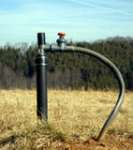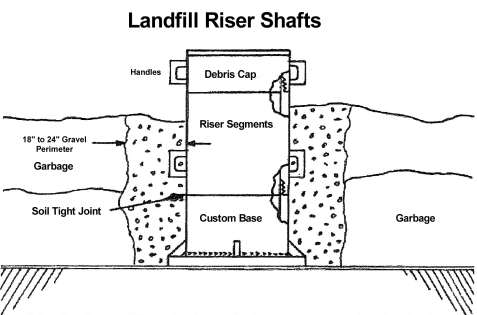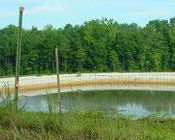
|
a |
|
- |
|
- |
|
- |
| careers |
|
|||||||||||||||||||||||||||||||||||
|
municipal | industrial | marine & dredging | agriculture | sanitation | mining | electrical | irrigation | communications | residential | landfill | recreation | road & highway construction | geothermal heating | ventilation | hydronic | fireworks | fish farms | floating docks | culvert | pontoons | tile | material handling |
||
Whether you manage a public landfill, a waste management system or just a privately owned garbage dump, the protection of the environment is going to be your paramount concern and a heavy responsibility. Designed to hold our garbage and to prevent it from contaminating our soil and our drinking water, the modern landfill has become a highly technical and complex structure. Contrary to what many might think, a landfill is not just a pile of garbage. To comply with federal mandates, a modern landfill has become complex system of rows and layers of garbage compacted into a series of cells or lifts, all of which are enclosed by a bottom liner made from a durable synthetic plastic, and embedded with a sophisticated system of plastic pipe.
Advantages of HDPE Landfill Gas Pipe
Our polyethylene pipe is used for wastewater distribution
where flexibility, corrosion resistance and durability are important
considerations. Landfill conditions present unique challenges for
any piping system. In a landfill, a piping system will have to withstand
external loads, be highly resistance to corrosive chemicals and
harsh environmental conditions. The flexibility and light weight
features of polyethylene pipe make it easy to assemble and install
especially where conditions are far from perfect. One of the biggest
advantages of using our pipe is its promise of leak free operation.
Because our landfill gas pipe can be joined by heat fusion, landfill
gas can be transferred to the processing plant without any fear
of leakage and harm to the surrounding environment.
As with many sanitary landfill projects, corrugated high density polyethylene pipe is used for leachate collection. Some of the pipe has to be buried beneath the landfill to divert the flow of water and resist any attack from chemicals that might leak out of the landfill. The inert properties of corrugated HDPE pipe allow it to handle strong leachate solutions ranging in pH from 1.5 to 14. The leak free pipe ensures that the landfill doesn't violate any regulations by contaminating the groundwater.
 Plastic
Pipe for Leachate Collection
Plastic
Pipe for Leachate Collection
The most important thing you can do to prevent your garbage
from polluting the environment is to keep it as dry as possible.
When water is allowed to seep through your garbage, it collects
all the contaminants in the garbage creating something called leachate
or highly acidic water. To reduce leachate, a lot of landfills will
put your garbage through filters to remove any excess liquid and
will install perforated plastic storm drainage pipe and storm
liners to collect rainwater. These pipes collect the water and move
it to the drainage ditches surrounding the landfill site which drain
into a leachate collection pond From there the leachate is released
to a wastewater treatment plant where it is treated and recycled
back into the environment.
 Plastic
Pipe for Methane Extraction
Plastic
Pipe for Methane Extraction
Another major problem with landfills, or any collection of compressed
garbage, is the production of methane gas. When your garbage is
compressed there is very little room for any oxygen. When bacteria
breakdowns your garbage, it creates a landfill gas, which contains
mostly methane and carbon dioxide with small amounts of nitrogen
and oxygen. To prevent the gas from exploding or bursting into flames,
a system or series of plastic pipes are embedded within the landfill
to extract the gas. In some cases, this gas is vented, burned off
or the methane is extracted and used as usable energy source.
Landfill Riser Shafts
Once a leachate collection system is installed the landfill
will need risers over some of these pipes for periodic maintenance.
These riser shafts must have pipe continuously added to the riser
as the lifts of garbage and soil cover increase in height. Flanged
pipe spools are "grabbed" by the settlement of the garbage inducing
vertical axial buckling of the riser pipe column. Riser shafts must
be smooth on the OD to avoid vertical crushing! Vertical butt-fusion
of the large diameter pipes (with its smooth OD) is virtually impossible.
Hence, mechanical joining of the HDPE riser pipe is the answer!
The landfill riser system is composed of three segments: the Base, the Riser-Segment and the Cap. All these pipe components are fabricated from ruggedized HDPE pipe with at least 46 psi pipe stiffness. Each segment hand-screws into the other using two men laborers. As the garbage level rises and the riser needs to be vertically extended, the debris cap is unscrewed and removed by hand. The new Riser-Segment is hand threaded into place and the debris cap is reinstalled by hand threading it back into position. The short-length and lightweight HDPE pipe combine to make this a very practical system!

Call for a quote on the custom base needed for your landfill; add to it all the risers segments needed, and one debris-cap; and the landfill riser shaft is complete. The end user will want its engineer to do a structural analysis to verify adequacy of pipe for burial depth.
|
Nominal |
Custom Base |
Riser Segments |
Debris Cap |
|
|
Size |
(1.5" PL + 10ft) |
5 ft long |
10 ft long |
(with handles) |
|
24" ID |
|
|
|
|
|
36" ID |
|
|
|
|
|
42" ID |
|
|
|
|
Contact
us today by email or our toll free number:
sales@oxfordplasticsinc.com
1.800.263.0502
|
Copyright ® 2003 - 2008 | Oxford Plastics Inc. | All Rights Reserved |
|||
|
Oxford Plastics Inc. ~ PO Box 119, Oxford Road 6, Embro, Ontario, CANADA, N0J 1J0 |
|||
|
Office: 519.423.6232 ~ Fax: 519.423.6057 ~ Toll Free: 1.800.263.0502 |
 Landfill
Gas Pipe
Landfill
Gas Pipe